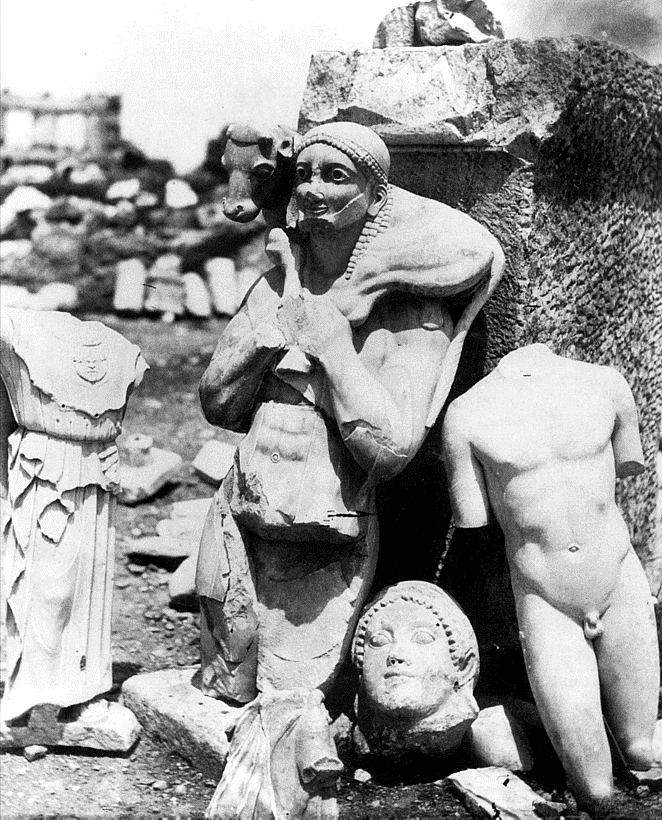
Perserschutt
Encyclopedia

German language
German is a West Germanic language, related to and classified alongside English and Dutch. With an estimated 90 – 98 million native speakers, German is one of the world's major languages and is the most widely-spoken first language in the European Union....
term meaning "Persian debris", or "Persian rubble", refers to the bulk of architectural and votive sculptures that were damaged by the invading Persian army
Army
An army An army An army (from Latin arma "arms, weapons" via Old French armée, "armed" (feminine), in the broadest sense, is the land-based military of a nation or state. It may also include other branches of the military such as the air force via means of aviation corps...
on the Acropolis of Athens
Acropolis of Athens
The Acropolis of Athens or Citadel of Athens is the best known acropolis in the world. Although there are many other acropoleis in Greece, the significance of the Acropolis of Athens is such that it is commonly known as The Acropolis without qualification...
in 480 BC.
The Athenians had fled the city, returning only upon the departure of the Persians. The city had been sacked and burned and most of the sacred temples had been looted, vandalized, or razed. The desecrated items were buried ceremoniously by the Athenians. Later, the citizens of Athens cleared the top of their acropolis
Acropolis
Acropolis means "high city" in Greek, literally city on the extremity and is usually translated into English as Citadel . For purposes of defense, early people naturally chose elevated ground to build a new settlement, frequently a hill with precipitous sides...
, rebuilt their sacred temple
Temple
A temple is a structure reserved for religious or spiritual activities, such as prayer and sacrifice, or analogous rites. A templum constituted a sacred precinct as defined by a priest, or augur. It has the same root as the word "template," a plan in preparation of the building that was marked out...
s, and created new works of sculpture
Sculpture
Sculpture is three-dimensional artwork created by shaping or combining hard materials—typically stone such as marble—or metal, glass, or wood. Softer materials can also be used, such as clay, textiles, plastics, polymers and softer metals...
to be dedicated for the new temples.
The remains were preserved by the respectful action and sculptures from the burial were first excavated in 1863-1866 by the French archaeologist Charles Ernest Beulé
Charles Ernest Beulé
thumb|Beulé's grave at the [[Père Lachaise Cemetery]] in ParisCharles Ernest Beulé was a French archaeologist and politician.-Biography:...
. The remainder was discovered in 1885-1890 by archaeologist Panagiotis Kavvadias and architect
Architect
An architect is a person trained in the planning, design and oversight of the construction of buildings. To practice architecture means to offer or render services in connection with the design and construction of a building, or group of buildings and the space within the site surrounding the...
s Wilhelm Dörpfeld
Wilhelm Dörpfeld
Wilhelm Dörpfeld was a German architect and archaeologist, the pioneer of stratigraphic excavation and precise graphical documentation of archaeological projects...
and Georg Kawerau. They include such celebrated sculptures as the Kritios Boy
Kritios Boy
The marble Kritios boy or Kritian Boy belongs to the Late Archaic period of ancient Greek sculpture; "the first beautiful nude in art", as Kenneth Clark thought, it is a precursor to the later classical sculptures of athletes...
, the Calf Bearer
Moscophoros
Moscophoros is an ancient Greek statue of cow-bearer . It is currently housed in the Acropolis Museum in Athens, Greece. Through the sculpture, We can see the genetic connection between sumer and the ancient Greeks....
, and the aegis
Aegis
An aegis is a large collar or cape worn in ancient times to display the protection provided by a high religious authority or the holder of a protective shield signifying the same, such as a bag-like garment that contained a shield. Sometimes the garment and the shield are merged, with a small...
-clad Athena (photograph, right).
Details of the excavations were published in 1906 (see references: Kavvadias, P., Kawerau, G.).
See also
- the Archaic Acropolis
- Kritios BoyKritios BoyThe marble Kritios boy or Kritian Boy belongs to the Late Archaic period of ancient Greek sculpture; "the first beautiful nude in art", as Kenneth Clark thought, it is a precursor to the later classical sculptures of athletes...
- MoscophorosMoscophorosMoscophoros is an ancient Greek statue of cow-bearer . It is currently housed in the Acropolis Museum in Athens, Greece. Through the sculpture, We can see the genetic connection between sumer and the ancient Greeks....
- Acropolis MuseumAcropolis MuseumThe Old Acropolis Museum was an archaeological museum located in Athens, Greece on the archeological site of Acropolis. It is built in a niche at the eastern edge of the rock and most of it lies beneath the level of the hilltop, making it largely invisible. It was considered one of the major...

